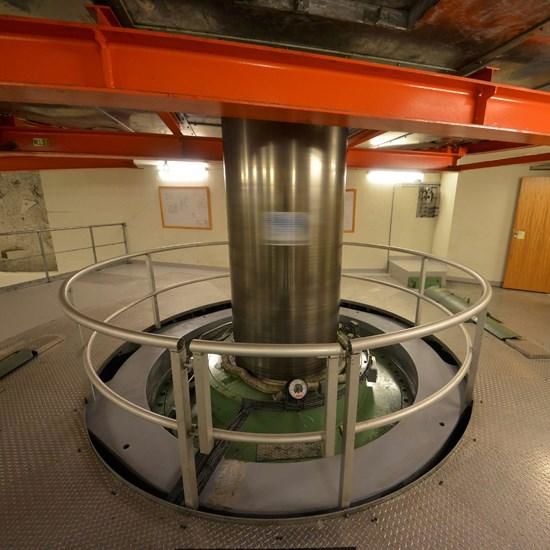
HOW IT WORKS
Different countries have different types of technologies for producing electricity as well as different ways of ensuring a stable power supply. Quite a few countries, including Ireland, do not have access to large amounts of hydropower or nuclear power and, until now, needed to operate coal or gas-fired power plants, which emit large amounts of CO2 , to ensure a steady frequency in the power grid.
In practice, this means that on an increasingly regular basis, these power plants are run only to stabilise the grid, even though there is more than enough power from wind and solar to cover electricity needs.
This is where the synchronous compensator comes in.
In such situations, the synchronous compensators supply kinetic energy to the system, stabilise the frequency until other power plants, batteries or hydropower plants can increase their power production, and return the power system to balanced operation.
In other situations with a sudden excess of power, the synchronous compensator can absorb power.
These machines are designed to deliver the inertia needed to stabilise the grid and thus eliminate the need to run fossil-fired power plants.

Electricity has traditionally been generated and transmitted from fossil fuel power stations to homes and businesses. As it is transmitted the levels of generation have to be managed so they are exactly equal to levels being used, and properties like voltage and frequency are minutely regulated across the whole network to ensure power generated at scale in industrial power stations could be used by domestic appliances plugged into wall sockets. These voltage and frequency regulating properties are known as grid ancillary services and include services called inertia and reactive power. Traditionally, these services have also been provided by fossil fuel power stations.
However, as renewable energy levels increase on the grid and the level of fossil fuel power decreases an alternative, zero-carbon, source of these grid ancillary services needs to be delivered. The Synchronous Compensator is a zero-carbon solution to provide ancillary services to the grid such as inertia and reactive power.
The electricity you use in your home to turn on the lights is called active power. However, getting active power to go around the country efficiently, economically and safely requires something called ‘reactive power’ which is a by-product of our mainly alternating current (AC) electricity transmission system.
Power stations aren’t the only source of reactive power. Household appliances also produce and feed small amounts of reactive power back into the grid. This can increase the amount of reactive power on the grid, so power stations must absorb the excess.
That’s because, although reactive power is essential, it is more important to have the right amount on the grid. Too much or too little reactive power in a given location and the voltage level in that area of the grid becomes unstable for the equipment connected to the grid.
Managing reactive power ensures active power is delivered to the places it needs to be. But it also means controlling voltage across the grid.
As our energy system decarbonises, the traditional sources of this reactive power voltage regulation- fossil fuel power stations- are running less often. This creates a greater need for machines such as the synchronous compensator proposed in this scheme to generate or absorb reactive power from the system to avoid voltage instability.
Inertia is an object’s natural tendency to keep doing what it is currently doing.
The inertia of the synchronous compensator can be used to act as a damper on the whole system to slow down and smooth out sudden changes in system frequency across the network – much like a car’s suspension it helps maintain stability.
The proposed synchronous compensator is simply a large heavy motor synchronised onto the grid frequency, and it replaces the missing inertia on a grid with high levels of renewables, thus smoothing the grid frequency against any external fluctuations. The synchronous compensator can also produce or consume reactive power, which is valuable for stabilising the grid voltage. This machine produces no active power (the power which we all use to run our homes and businesses) and only consumes active power in order to maintain its’ rotation synchronised to the grid frequency.
The electricity grid doesn’t just move power around, it does so using alternating current which is a fixed 50Hz sine wave, completing 50 cycles per second. That grid frequency is experienced by all generators and motors and users of the grid. It’s important that it is stable. If there’s a discrepancy between generation and demand on the grid at any point in time, then the frequency will deviate from 50Hz.
Any spinning machines connected (synchronously) to the grid will then have to speed up or slow down to match. The weight or inertia of those machines is useful, in that it dampens down sudden movements, allowing time for other generators to pick up the slack (or ease off as appropriate). The problem is that wind, solar and other non-traditional sources of electricity don’t offer any such inertia to the grid. There is a danger that the more of these facilities we have, the lighter (lower inertia) the grid will become, and the inevitable disturbances are not sufficiently damped down.
Traditionally the only sources of inertia and reactive power were fossil fuel plants, but now there are other options. The synchronous compensator means that we don’t need to keep turning on old fossil fuel power stations just to provide these services. Each year the grid wastes millions of euros and nearly a million tonnes of CO2 a year in running fossil fuel power stations just to secure inertia, reactive power and other grid ancillary services, even though those power stations are not needed for electricity because there is plenty of renewable generation to meet demand.
Evolving our electricity grid system to include synchronous compensators and other grid stability services will reduce and ultimately eliminate this wastage entirely and form a critical step in moving towards a Zero-Carbon electricity grid system.